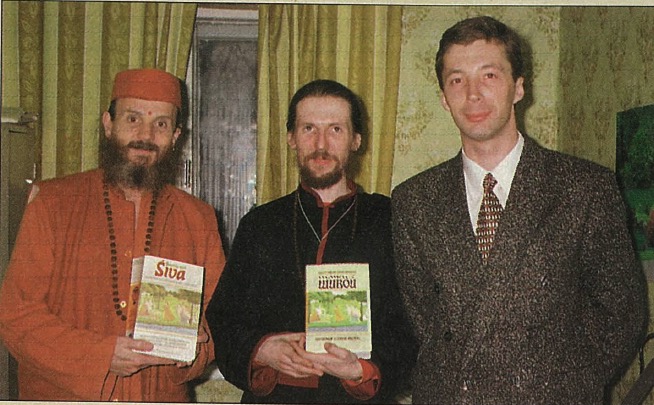Four years of on-again, off again effort came to fruition for Swami Sadashivacharya on April 27 at Moscow’s Moskva conference hall. On that brisk spring day the Russian language version of Dancing with Siva was released. Russian books on Hinduism are few; so this encyclopedic tome–1,008 pages in the original English–fills a wide gap at a critical time in the evolution of the nation’s spiritual consciousness.
By timely and judicious compromises, the Russian Orthodox Church survived 80 years of communist rule. But the institution that limped into freedom’s dawn was a mere shadow of the mighty mentor of all things Russian it had once been. The old folks had clung to their faith over the years, but the new generation was educated on communist doctrines which dismissed religion’s necessity. Now, with communism itself relegated to the netherworld of failed social experiments, religion is an appealing, untested option for Russian youth. And just as India once looked to the Soviets for inspiration and guidance in forming a socialist country, seekers of the disbanded Union now look to India as the world’s primeval fountain of wisdom and knowledge.
It was such a quest that took the young Swami Sadashivacharya to India years ago. He and other seekers formed Moscow’s Tantra Sangha in 1992, with the intent of promoting Hindu Tantric philosophy and worship. When he met Hinduism Today publisher Satguru Sivaya Subramuniyaswami in Berlin in 1993, he was presented a copy of Dancing with Siva. “At the very first moment of getting it, I was deeply impressed and wished to do everything possible to make a Russian version,” recalls Swami. “I asked Gurudeva for his blessing to translate the book, and immediately, without any words, he put his hands upon my head and gave his blessings.” Swami knew the book would fill the great void in Russian-language publications for comprehensive books on Indian spirituality. “There are several hundred books on Hinduism in Russia,” Swami said, “but most of them are very simple, thin and unillustrated.” Dancing with Siva covers every aspect of Hinduism in question/answer format, and includes extensive references on major Hindu denominations, hundreds of carefully defined Sanskrit terms, a timeline of Hindu history, material for parents and children, a synopsis of each of the world’s major religions and abundant illustrations.
Leo Ozolin began the massive translation task immediately upon Swami’s return to Russia in 1993, but soon stopped for lack of funds. In 1996, Sophia Publishing company took an interest in adding the Catechism to their titles on yoga, New Age, healing, meditation and transpersonal psychology. Two professional translators, Peter Aleinikov of Moscow and Andrey Kostenko of Dnepropetrovsk, Ukraine, were hired to complete the text. They divided the book between them, and reported easy going with the translation, though they admitted, “The Sanskrit terms were hard.” Aleinikov, who spent a full year on the project, believes it is a useful work as “Russian people are very interested in Hindu philosophy.” Kostenko was inspired by “the divinity, integrity and ease-of-understanding brought to the complex subject of Hinduism.” He served as proofreader and production motivator while Swami Sadashivacharya provided editing and organizational input. The high-quality, hardbound text is now available for US$12 to $15 in Russian stores–a moderate price within reach of even a student’s budget. The reception is “very warm and excellent,” Swami reports.
Paramacharya Bodhinatha Veylanswami of Himalayan Academy Publications–publishers of Dancing with Siva and, we need disclose, Hinduism Today–flew to Russia for the book release. He reports a successful event with a number of distinguished speakers enthusiastically endorsing the book, including the publisher, scholars and leaders of several spiritual groups, notably Vladimir B. Avdeyev, chairman of the Russian Pagan community and Sri Vaidyanath das, president of the Russian branch of ISKCON.
The most unexpected revelations came from speaker Yuri P. Shilov, an archeologist of Ukraine. He explained how his life had been transformed when his archeological research into Ukraine’s history revealed that the region’s early culture was Vedic. As a Marxist at the time, this came as a great shock. Mainstream scholars had not suspected such a strong Ukraine-India connection. But other evidence was already at hand, including the ten-kopek Ukraine coin bearing the country’s national symbol–the Hindu trident! Shilov plans to join new digs in India, and to team up with visiting Indian archeologists in his own land.
Kim I. Shilin, a scholar in the “Laboratory of East Culture’s Ecology,” Institute of Asian-African Studies, Moscow University, praised the Indian approach, which “treats life as a whole and seeks revival of the initial harmony,” an outlook he hopes will counterbalance the impact of the West’s aggressive, materialistic philosophy.
There is no permanent Indian presence in Russia. Indians come from Bharat for a few years, but then return. This differs from the Western paradigm, where resident Indian Hindu populations have built temples, established their teachings and given strength to inspired Westerners. Russia’s seekers with Hindu leanings are on their own (though India is not that far away). Thus, they are encouraged by the section in Dancing with Siva on how people not born into the faith can enter Hinduism through study, severance and traditional rites. Meanwhile, others in the former USSR are turning to Paganism, the land’s pre-Christian faith, sparking a grassroots revival, as is also happening in Europe. Pagans in both communities are discovering, too, that their ancient heritage is closely akin to Hinduism.
The Russian version ofDancing with Sivais available from the Tantra Sangha, P.O. Box 70, Moscow 103055, Russia.
